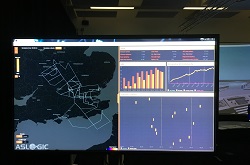Air traffic management for the future
The PARTAKE(opens in new window) Horizon 2020 project applied innovative procedures and technologies to tackle the upcoming air traffic management (ATM) challenges from growing air travel demand. The initiative is funded within the framework of the SESAR Joint Undertaking, a public-private partnership set up to modernise Europe's ATM system. Project partners aimed to contribute to the improvement of the flow of aircraft into European airspace by minimising the probability of potential ‘conflicts’. This is when two or more aeroplanes temporarily converge at a precise point where the safe separation minima are potentially lost. The goal was to resolve factors dependent on time and space and provide airports connected by the ATM system with a global vision. “At present, despite the huge amount of existing real-time data concerning airports, aircraft, air space sectors – and how they will evolve in the future – there are no tools for analysing time-space interdependencies between such actors,” says project coordinator Prof. Miquel Angel Piera. Consortium members implemented an innovative decision support system that coordinates flight departures according to airport information on taxiways and runway status, as well as the airside state. “We analyse the spatial and temporal interdependencies between flightpaths and support implementation of mitigation mechanisms that reduce the probability of air traffic controller interventions, while preserving air space capacity and airline preferences,” Prof. Piera explains. Air space digitalisation Researchers developed new digitalisation tools supporting the spatial and temporal information analysis of the air traffic to identify concurrence events (potential conflicts) and created a multi-airport planner decision support tool to facilitate the smooth flow of flight departures. Key results of the new spatial and temporal digitalisation methodologies include creating a baseline to support the design of new metrics for analysing the conflict situation that complement the conventional entry and occupancy counters. The new proposed metrics are represented in a dashboard showing time-based information of selected sectors, the locations and duration of conflicting situations and the flights involved. Furthermore, new metrics are used to calculate the mitigation measures maintaining airspace capacity, reducing the probability of controller interventions and preserving airspace user preferences. The project also provided a framework for managing uncertainties in flightpaths generated at the airport level or due to weather conditions. Everyone benefits PARTAKE will extend the life of some current ATM tools by providing them with new functions that enhance the tools available to air navigation service providers. Integration with airport collaborative decision-making tools will improve prediction of airport processes and provide better departure sequence to improve runway performance and reduce the probability of air traffic control interventions. The project will also benefit airspace users by reducing the need for conflict resolution and improving the acceptability of new technologies by engaging end-users throughout validation and final human machine interface design. “A tool for coordinating aircraft departure between airports avoiding airside conflicts will provide economic benefits for airlines and airports and improve passenger punctuality,” concludes Prof. Piera.







